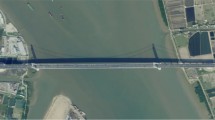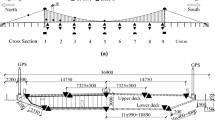Abstract
A 3D finite element model (FEM) with realistic field measurements of temperature distributions is proposed to investigate the thermal stress variation in the steel–concrete composite bridge deck system. First, a brief literature review indicates that traditional thermal stress calculation in suspension bridges is based on the 2D plane structure with simplified temperature profiles on bridges. Thus, a 3D FEM is proposed for accurate stress analysis. The focus is on the incorporation of full field arbitrary temperature profile for the stress analysis. Following this, the effect of realistic temperature distribution on the structure is investigated in detail and an example using field measurements of Aizhai Bridge is integrated with the proposed 3D FEM model. Parametric studies are used to illustrate the effect of different parameters on the thermal stress distribution in the bridge structure. Next, the discussion and comparison of the proposed methodology and simplified calculation method in the standard is given. The calculation difference and their potential impact on the structure are shown in detail. Finally, some conclusions and recommendations for future bridge analysis and design are given based on the proposed study.
摘要
对钢–混组合结构温度梯度效应的研究, 主要是以竖向温度梯度结合二维有限元模型开展的; 而对大跨度桥梁实测温度梯度的研究发现, 其具有典型的空间特性。 鉴于此, 以矮寨大桥为研究背景, 对大跨度悬索桥钢–混组合桥面系的周年实测空间温度梯度进行实测研究, 建立大跨度悬索桥钢–混组合桥面系的空间有限元节段模型, 研究在空间温度梯度耦合作用下, 桥面系结构参数与力学响应之间的关系, 得出的结论可为同类结构的建养提供有益的参考。
Similar content being viewed by others
References
DING Y L, LI A Q, GENG F F. Damage warning of suspension bridges based on neural networks under changing temperature conditions [J]. Journal of Southeast University: Eng Edi, 2010, 26(4): 586–590. (in Chinese)
CHOI C K, NOH H C. Ultimate strength of RC cooling tower shells subjected to temperature and wind loads [J]. J Korean Soc Civ Eng, 1999, 19(14): 469–469.
SALAWU O S. Detection of structural damage through changes in frequency: A review [J]. Eng Struct, 1997, 19(9): 718–723.
GIUSSANI F. The effects of temperature variations on the long-term behavior of composite steel-concrete beams [J]. Eng Struct, 2009, 31(10): 2392–2406.
CHEN X Q, LIU Q W, ZHU J. Measurement and theoretical analysis of solar temperature field in steel-concrete composite girder [J]. Journal of Southeast University: Eng Edi, 2009, 25(4): 513–517. (in Chinese)
XIA Y, CHEN B, ZHOU X Q, XU Y L. Field monitoring and numerical analysis of Tsing Ma Suspension Bridge temperature behavior [J]. Struct Control Health Monit, 2013, 20(4): 560–575.
DING Y L, WANG G X, ZHOU G D. Life-cycle simulation method of temperature field of steel box girder for Runyang cable-stayed bridge based on field monitoring data [J]. China Civ Eng, 2013, 46(5): 129–136. (in Chinese)
EUROCODE C E N. Design of composite steel and concrete structures II: Bridges [S]. European Committee for Standardization, 1994.
JTG D62–2004. Design code for design of highway reinforced concrete and pre-stressed concrete bridge culvert [S]. China, 2004. (in Chinese)
AASHTO. AASHTO LRFD bridge design specifications [S]. Washington D.C: AASHTO, 2007.
KOCATURK T, AKBAS S D. Thermal post-buckling analysis of functionally graded beams with temperaturedependent physical properties [J]. Steel Comp Struct, 2013, 15(5): 481–505.
DÜĞENCI O, HAKTANIR T, ALTUN F. Experimental research for the effect of high temperature on the mechanical properties of steel fiber-reinforced concrete [J]. Constr Build Mater, 2015, 75: 82–88.
XIA Y, HAO H, ZANARDO G, DEEKS A. Long term vibration monitoring of an RC slab: temperature and humidity effect [J]. Eng Struct, 2006, 28(3): 441–452.
MACDONALD J H, DANIELL W E. Variation of modal parameters of a cable-stayed bridge identified from ambient vibration measurements and FE modeling [J]. Eng Struc, 2005, 27(13): 1916–1930.
YIN C X. Computing method for effect analysis of temperature and shrinkage on steel-concrete composite beams [J]. China J Hwy Trans, 2014, 27(11): 76–83. (in Chinese)
ZIVICA V, KRAJCI L, BAGEL L, VARGOVA M. Significance of the ambient temperature and the steel material in the process of concrete reinforcement corrosion [J]. Constr Build Mater, 1997, 11(2): 99–103.
THURSTON S J, PRIESTLEY M J N, CDOKE N. Thermal analysis of thick concrete sections [J]. ACI J, 1980, 77(5): 347–357.
ELBADRY M M, GHALI A. Temperature variation in concrete bridges [J]. Journal of Structural Engineering, 1983, 109(10): 2355–2374.
DENG J, LEE M M K, LI S. Flexural strength of steel–concrete composite beams reinforced with a prestressed CFRP plate [J]. Constr Build Mater, 2011, 25(1): 379–384.
XU X, LIU Y, HE J. Study on mechanical behavior of rubber-sleeved studs for steel and concrete composite structures [J]. Constr Build Mater, 2014, 53: 533–546.
ATTIA A, TOUNSI A, BEDIA E A, MAHMOUD S R. Free vibration analysis of functionally graded plates with temperature-dependent properties using various four variable refined plate theories [J]. Steel Comp Struct, 2015, 18(1): 187–212.
RIDING K A, POOLE J L, SCHINDLER A K, JUENGER M C, FOLLIARD K J. Temperature boundary condition models for concrete bridge members [J]. ACI Mater J, 2007, 104(4): 379–387.
Author information
Authors and Affiliations
Corresponding author
Additional information
Foundation item: Project(2015CB057701) supported by the National Basic Research Program of China; Project(51308071) supported by the National Natural Science Foundation of China; Project(13JJ4057) supported by Natural Science Foundation of Hunan Province, China; Project(201408430155) supported by the Foundation of China Scholarship Council; Project(2015319825120) supported by the Traffic Department of Applied Basic Research, China; Project(12K076) supported by the Open Foundation of Innovation Platform in Hunan Provincial Universities, China
Rights and permissions
About this article
Cite this article
Wang, D., Deng, Y., Liu, Ym. et al. Numerical investigation of temperature gradient-induced thermal stress for steel–concrete composite bridge deck in suspension bridges. J. Cent. South Univ. 25, 185–195 (2018). https://doi.org/10.1007/s11771-018-3728-5
Received:
Accepted:
Published:
Issue Date:
DOI: https://doi.org/10.1007/s11771-018-3728-5
Key words
- suspension bridge
- steel–concrete composite bridge deck
- vertical temperature gradient
- finite element method
- thermal stress




